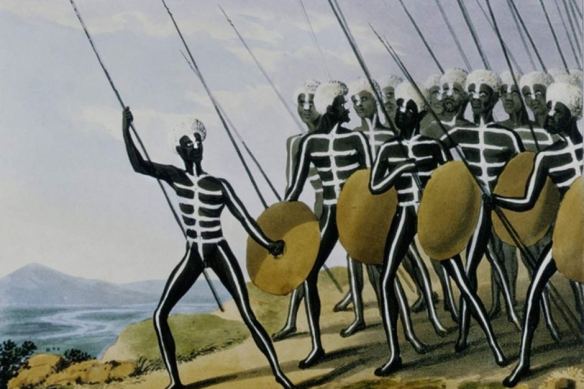Depicts Aboriginal men, wearing body paint and paint (or clay) on heads carrying spears and shields.This is one of the earliest works in the art collection which reveals much about the commonly held views of Aboriginal people during the Colonial period in Australia. John Heaviside Clark’s image depicts a number of Aboriginal men wearing body paint, carrying spears and shields depicted in a theatrically aggressive manner.
Clark (c.1770-1863) was a landscape painter, commercial artist, book illustrator and engraver who worked in London. Although as an artist he espoused sketching directly from nature, it is doubtful that Clark actually visited Australia to record the Aboriginal warriors he so dramatically captures in this work. His work reveals the fanciful beliefs prevalent at the time of indigenous people as ‘naked savages’ and illustrations in this vein were largely designed to meet the British public’s interest in the ‘curiosities to be found in the colony of New South Wales’ .
Parramatta was the site of a skirmish in March 1797 in which Bidjigal (Bediagal) Aborigines fought white settlers and troops of the New South Wales Corps. The clash followed depredations upon settlers in the Toongabbie district, led by the Aborigines’ noted guerilla leader Pemulwuy. An armed party was sent after the marauders, and following a pursuit lasting throughout one night came across their quarry-numbering about 100-the next day. The Aborigines fled, leaving the spoils of their raids on the ground. The punitive expedition pursued the hostile band into the Parramatta district but-becoming fatigued-eventually retired into the town. The Aborigines followed them there, with Pemulwuy at their head threatening to kill the first white man who approached him. He effectively challenged the town’s military garrison to battle by hurling his spear at one of the soldiers. What was described as a `desperate fight’ followed, in which Pemulwuy and his followers pitted their spears against the muskets of the troops and settlers. Five Aborigines were killed and many more wounded, including Pemulwuy who was made prisoner with seven buckshot hits in his head and body. He was taken to the hospital, but subsequently escaped to play a leading role in numerous other incidents until he was finally shot dead by two settlers late in 1802.
Heidelberg, now an outer suburb of Melbourne, Victoria, was in May 1840 the scene of an extraordinary confrontation between white settlers and Aborigines using European firearms seized in raids on shepherds’ huts. Early in 1840 a large band of Aborigines led by Jackie Jackie made their presence felt on the upper reaches of the Yarra River during several incidents in which firearms were used. Attempts were made by white authorities to retrieve the weapons, but were too late. In May, Armyne Bolden, a settler based several kilometres up the Yarra from Melbourne, reported to the superintendent of the Port Phillip district, Charles La Trobe, that more than 200 Aborigines armed with about 30 guns were `shooting in every direction’ and threatening to burn down huts on his run.
A detachment of mounted police was sent out from Melbourne, but by the time this arrived the Aborigines had disappeared. Several troopers led by Lieutenant F. B. Russell tracked the band, but when they were about 65 kilometres upstream they were ambushed by the Aborigines who had concealed themselves in dense scrub by a ford. The police were fired on as they attempted to cross the stream, three were wounded and all were forced to retreat. The incident is chiefly notable for showing the Aborigines acting virtually as guerillas in opposing white occupation of their lands. The solution adopted by La Trobe was to issue orders to police patrols to prevent any Aborigines from entering Melbourne, and in particular to impose severe penalties on shopkeepers supplying powder and shot to any Aborigines, especially women, who sneaked into the town.
Eumeralla, the district around the Eumeralla River between Port Fairy and Portland, Victoria, was in August 1842 the scene of several violent clashes between Aborigines and whites over the `theft’ of sheep. On 7 August Aborigines attacked a shepherd employed by James Hunter, who held Eumeralla station with his brother John, and drove off his flock. The station manager, Samuel MacGregor, and several hands pursued them and took back the sheep after `a severe skirmish’. On 10 August a group of Aborigines estimated to number more than 150 again appeared on the station, part of the group driving off the sheep while the rest attacked the shepherds. This time the latter were well armed and kept them at bay until help arrived, whereupon the Aborigines made off and the flock was recovered.
Eight days later there was a third large-scale attack, with this time the tribesmen taking away over 1,000 sheep. A party from the station which went out in pursuit found the flock’s trail littered with dead carcasses. About thirteen kilometres from the station the party came up against the Aborigines, and only after overcoming `a vigorous resistance’ (during which three warriors were shot dead and several others wounded) were they able to retake the 500 or so sheep which remained alive.
These clashes were repeated on neighbouring stations of the district to the north-west of Port Fairy over the next five years, reaching a peak of ferocity from early in 1845. Tom Browne-a local squatter who wrote novels under the pseudonym of Rolf Boldrewood-characterised this period as `The Eumeralla War’ in his 1884 book of recollections Old Melbourne Memories.
